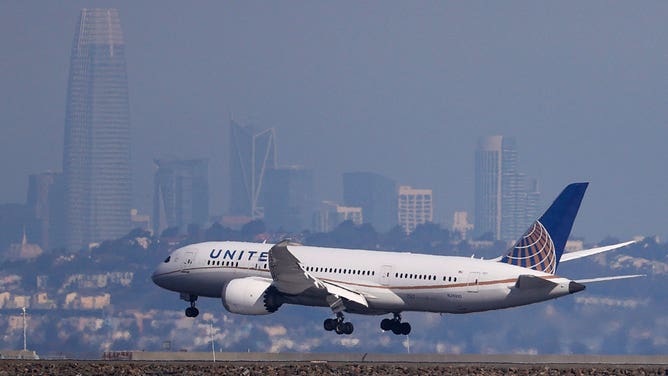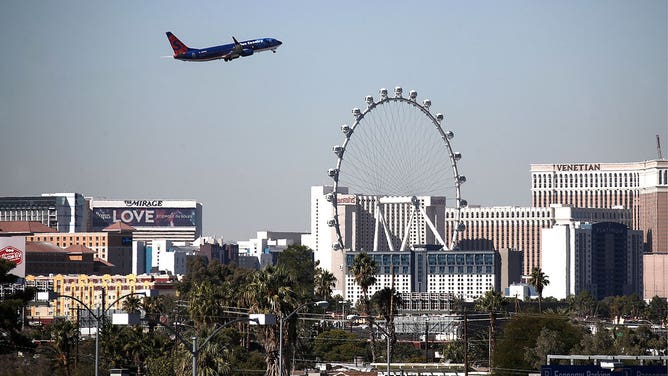How extreme heat can affect air travel
Airlines have contingency plans to deal with extreme temperatures

A United Airlines 787 Dreamliner lands at San Francisco International Airport on October 19, 2021 in San Francisco, California.
(Justin Sullivan/Getty Images)
The summer of 2021 saw heat bake parts of the United States that typically don’t deal with high temperatures. In the Pacific Northwest, records that had stood for decades were shattered as thermometers climbed into the triple digits.
Extremes in any type of weather can have adverse impacts on everything from health to travel, and extreme heat is no different. In fact, airlines sometimes have to modify their plans when excessive heat blankets a region.
John Weigand is the managing director of station operations at Newark Liberty International Airport. He’s also been a pilot for United Airlines for 30 years and flies Boeing’s 757 and 767 airplanes. He said he sees extreme heat as a two-fold issue: aircraft performance and customer comfort.
Aircraft performance
Weigand said anytime the air is excessively hot or cold, the performance of the aircraft’s engines is affected. On extremely cold days, performance is improved. On extremely hot days, performance is reduced. That’s because hot air is much less dense than cold air.
"The performance of the engine is not the same at 100 degrees Fahrenheit as it would be at 32 degrees Fahrenheit because of the intake of the less dense air," Weigand said.

A Southwest Airlines plane flies over the Las Vegas Strip on Nov. 1, 2019.
(Valery Sharifulin/TASS via Getty Images)
Another factor in this equation is the elevation of the airport in question. Weigand said extreme temperatures are much less of a factor with airports that are at sea level. That’s because the air is much denser at lower elevations than higher elevations. For example, Denver, Colorado, where the elevation is 5,280 feet or a mile above sea level.
"You now have two things working against you," Weigand said. "The altitude, where there's less dense air, and the heat, where there's less dense air, and we find the performance issues can affect us there in Denver."
Dealing with aircraft performance issues
Airplanes can fly because of the lift that is generated by passing air over the wings at high speeds. According to Weigand, the less dense air created by extreme heat at some airports means pilots and airlines will sometimes have to modify loading and takeoff plans in order to achieve the necessary amount of lift.
"You need ... more air over the wing, faster, a faster speed to achieve the same amount of air over the wing that you would on a colder day," Weigand said.
According to Weigand, this can be achieved in a couple of ways. One is by reducing the weight of the aircraft.
"To ensure safety and the aircraft has the performance in case of engine failure, we have to sometimes limit the amount of cargo and, in rare cases, the number of passengers that would be on the aircraft," Weigand said.
According to the Federal Aviation Administration, airlines can also reduce the amount of fuel that is loaded onto an aircraft to make the aircraft lighter.

Volaris Airbus A320-200 aircraft seen at Phoenix Sky Harbor International Airport on Feb. 22, 2020.
(Alex Tai/SOPA Images/LightRocket via Getty Images)
The other method is to increase the amount of thrust, or propulsive force, generated by the engines.
"When additional thrust is required, we can use our auxiliary power unit to cool the airplane, the APU, to cool the airplane, and in which case, we could then turn off the air conditioners or the ‘packs,’" Weigand said. "We do that on a regular basis to improve performance."
Customer comfort
Weigand said that from the captain’s seat, the comfort of his passengers is another big concern on extremely hot days. He said ground crews play an important role in that process.
"Our ground crews would come through post-flight and we would put all the shades down in the cabin," Weigand said. "We would open all the air vents so that we keep the aircraft cool so that our customers will be comfortable when they get on the airplane and as they clean the airplane."
Preparing for extremes
Climate change means airlines can expect more extremes in the weather.
Weigand said pilots have a multitude of tools and training at their disposal to make sure they’re able to handle whatever Mother Nature throws at them. He also said that United routinely conducts performance analysis of airports to ensure its aircraft are able to safely operate in that area.
According to Weigand, United is also investing in efforts to combat climate change, including a pledge to be carbon neutral by 2050.
"We've been at the forefront of the biofuel testing," Weigand said. "We are investing wisely in some electric aircraft that just came out with the Heart company there."
United has also announced intentions to buy electric helicopter-type aircraft to provide some services.